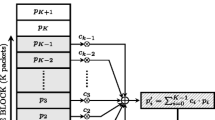Abstract
Wireless is becoming a popular way to connect mobile computers to the Internet and other networks. The bandwidth of wireless links will probably always be limited due to properties of the physical medium and regulatory limits on the use of frequencies for radio communication. Therefore, it is necessary for network protocols to utilize the available bandwidth efficiently. Headers of IP packets are growing and the bandwidth required for transmitting headers is increasing. With the coming of IPv6 the address size increases from 4 to 16 bytes and the basic IP header increases from 20 to 40 bytes. Moreover, most mobility schemes tunnel packets addressed to mobile hosts by adding an extra IP header or extra routing information, typically increasing the size of TCP/IPv4 headers to 60 bytes and TCP/IPv6 headers to 100 bytes. In this paper, we provide new header compression schemes for UDP/IP and TCP/IP protocols. We show how to reduce the size of UDP/IP headers by an order of magnitude, down to four to five bytes. Our method works over simplex links, lossy links, multi‐access links, and supports multicast communication. We also show how to generalize the most commonly used method for header compression for TCP/IPv4, developed by Jacobson, to IPv6 and multiple IP headers. The resulting scheme unfortunately reduces TCP throughput over lossy links due to unfavorable interaction with TCP's congestion control mechanisms. However, by adding two simple mechanisms the potential gain from header compression can be realized over lossy wireless networks as well as point‐to‐point modem links.
Similar content being viewed by others
References
M.G. Baker, X. Zhao, S. Cheshire and J. Stone, Supporting mobility in MosquitoNet, in: Proceedings of USENIX Technical Conference, San Diego, CA (January 1996).
H. Balakrishnan, S. Seshan, E. Amir and R.H. Katz, Improving TCP/IP performance over wireless networks, in: Proceedings of Mobile Computing and Networking Conference (MobiCom '95) (ACM Press, 1995) pp. 2–11.
D.D. Clark, The design philosophy of the DARPA Internet protocols, Comp. Comm. Rev. 18(4) (1988) 106–114. Also in Comp. Comm. Rev. 25(1) (1995) 102–111.
S. Deering, Host extensions for IP multicasting, Request For Comment 1112, Internet Engineering Task Force (1989). ftp:// ds.internic.net/rfc/rfc1112. {ps,txt}.
S. Deering and R. Hinden, Internet protocol, version 6 (IPv6) specifi-cation, Request For Comment 1883, Internet Engineering Task Force (1995). ftp://ds.internic.net/rfc/rfc1883.txt.
S. Deering, D. Estrin, D. Farinacci, V. Jacobson, C.-G. Liu and L. Wei, An architecture for wide-area multicast routing, Comp. Comm. Rev. 24(4) (1994) 126–135.
M. Degermark, B. Nordgren and S. Pink, Header compression for IPv6, Internet Draft (work in progress), Internet Engineering Task Force (1996). draft-degermark-ipv6-hc-02.txt.
D. Eckhardt and P. Steenkiste, Measurement and analysis of the error characteristics of an in-building wireless network, Comp. Comm. Rev. 26(4) (1996) 243–254.
D. Feldmeier and A. MacAuley, We owe the concept of a booster protocol to them.
V. Jacobson, Compressing TCP/IP headers for low-speed serial links, Request For Comment 1144, Internet Engineering Task Force (1990). ftp://ds.internic.net/rfc/rfc1144. {ps,txt}.
S. Keshav, The REAL network simulator. http://minnie.cs.adfa.oz.au/ REAL/.
A. Mathur and M. Lewis, Compressing IPX headers over WAN media (CIPX), Request For Comment 1553, Internet Engineering Task Force (1993). ftp://ds.internic.net/rfc/rfc1553.txt.
Network Research Group, Lawrence Berkeley National Laboratory, ns – LBNL Network Simulator. http://www-nrg.ee.lbl.gov/ns/.
G.T. Nguyen, R.H. Katz, B. Noble and M. Satyanarayanan, A trace-based approach for modeling wireless channel behaviour, in: Proceedings of Winter Simulation Conference (1996). http:// daedalus.cs.berkeley.edu/publications/wsc96.ps.gz.
C. Partridge, Gigabit Networking (Addison-Wesley, Reading, MA, 1993).
C. Perkins, ed., IP mobility support, Internet draft (work in progress), Internet Engineering Task Force (1996). draft-ietf-mobileipprotocol-16.txt.
C. Perkins and D.B. Johnson, Mobility support in IPv6, Internet draft (work in progress), Internet Engineering Task Force (1996). draft-ietf-mobileip-ipv6-00.txt.
J.L. Romkey, A non standard for transmission of IP datagrams over serial lines: SLIP, Request For Comment 1055, Internet Engineering Task Force (1988).
W. Simpson, The point-to-point protocol (PPP), Request For Comment 1661, Internet Engineering Task Force (1994).
W. Simpson, PPP in HDLC-like framing, Request For Comment 1662, Internet Engineering Task Force (1994).
L. Zhang, S. Deering, D. Estrin, S. Shenker and D. Zappala, RSVP: a new resource reservation protocol, IEEE Network Magazine (September 1993) 8–18.
Author information
Authors and Affiliations
Rights and permissions
About this article
Cite this article
Degermark, M., Engan, M., Nordgren, B. et al. Low‐loss TCP/IP header compression for wireless networks. Wireless Networks 3, 375–387 (1997). https://doi.org/10.1023/A:1019138108114
Issue Date:
DOI: https://doi.org/10.1023/A:1019138108114




